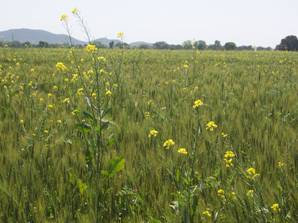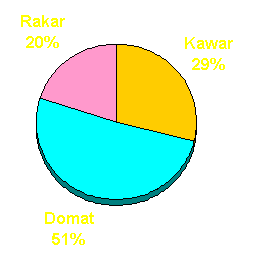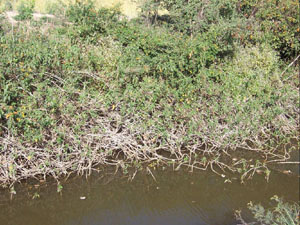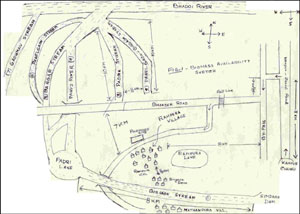|
Electrification Matters :
the Rampura challenge
Priyaranjan Sinha
psinha@devalt.org
R ampura
is a village in Jhansi district, Uttar Pradesh, 20 kms away from the
 district headquarters. Inspite of its proximity to Jhansi Medical
College and Bundelkhand University, which are within a radius of 8 kms,
the village still does not have any electricity. district headquarters. Inspite of its proximity to Jhansi Medical
College and Bundelkhand University, which are within a radius of 8 kms,
the village still does not have any electricity.
Total
population of Rampura is 350 and the dream of the local populace is
enjoy cool air of fan/ cooler or watch TV. All the villagers are
basically farmers and quite a few of them are engaged in one income
generating activity or other.
The main
crops are: -
| 1. |
Wheat –
Rabi Crop |
| 2. |
Pulse-
Kharif Crop |
| 3. |
Ground
Nut – Kharif Crop |
|
Three types of soil are
mainly evident in the region, such as: |
| 1. |
Red Soil
(local name - Rakar) |
| 2. |
Black
Soil (local name - Kawar) |
| 3. |
Mixed
Soil (local name - Domat) |
 The most
preferred is the mixed soil (on the basis of water consumption and
agricultural output). The most
preferred is the mixed soil (on the basis of water consumption and
agricultural output).
The farmers
of this village are dependent on 55 DG (Diesel Generator) pump sets for
the irrigation. Only dug wells exist, with almost all the farmers having
their own well, which is the main water source other than the rains.
Current
Situation
The village
is situated at a distance of two kilometres from the grid. The major
demand for electricity is for irrigation purposes, because of the fact
that the villagers cannot curb the galloping diesel price rise, which is
incurring more agriculture production cost and less profit. Again, the
nearest filling station is at ten kilometers away from the village,
which aggravates this problem.
|
Present
expenditure on irrigation (350 Acre) due to diesel is as follows: |
| · |
Dec. to March |
š |
Rs.
6,17,000/- |
|
· |
April to June |
š |
Rs,
4,14,000/- |
|
· |
July to
Nov. |
š |
Rs.
2,03,000/- |
| |
In
Total |
š |
Rs,
11,34,000/- |
There is
even a strong demand for domestic electricity connection due to the need
 to run fans, TV sets, coolers, etc. In some of the houses, the TV set
obtained in the marriage is still packed. to run fans, TV sets, coolers, etc. In some of the houses, the TV set
obtained in the marriage is still packed.
No enterprises are
evident in this village. Only one flour mill (atta chaki) is there,
which runs on DG engine. The establishment of the potential enterprises
like poultry farm, flour mill, battery charging, briquette production,
etc., is depending on the availability of quality electricity supply.
Opportunity
The
potential renewable energy technologies are Solar, Biogas and Biomass
based energy. Both solar and biogas are not considered as solar is
capital intensive and cow dung has other competing uses. The
non-forestry biomass (Ipomea) is available in huge quantity. Ipomea,
which is a weed, has been preferred over other available biomass because
of the following reasons:
| · |
It
regenerates faster |
|
· |
It is
mainly not used by the villagers for cooking as it burns
with obnoxious smoke. |
|
The areas from where the
biomass could be obtained are: |
|
Primary catchment
areas |
|
These areas are within 1
– 5 km from the village. These areas can meet the total biomass
requirement |
|
Backup catchment
areas |
|
· |
These
areas are within 10-12 km from the village. |
Possible Solutions
The biomass
gasification based power plant of 50 KW capacity has been considered as
the best option to start with. The
 availability of huge quantity of
biomass, justifies this fact, which can be collected by following the
harvesting cycle. availability of huge quantity of
biomass, justifies this fact, which can be collected by following the
harvesting cycle.
It will be
an open top down-draft system, where both gas and feed stock move
downward as the reaction proceeds. The gas obtained is called producer
gas (CO: 20 ± 2%, CH4: 3 ± 1%,H2: 20± 2%, CO2 : 12 ± 2% and rest is N2),
which can have both thermal and electrical applications.
Diesel
substitution of the order of 70 to 80% can be obtained in dual fuel
mode; the possibility of using 100% gas based engine will be analysed
and if it is used, it is bound to prove more economical.
"The FIs / Govt. Bodies are invited to be a partner
in this process of sustainable development"
|
Activity |
Status |
 |
| Biomass availability
study |
completed |
| Techno-economic
feasibility report |
completed |
| Interaction with the
community |
ongoing |
| Vendor selection for
the plant |
ongoing |
| Establishing service
delivery model |
yet to
be started |
| Negotiation with the
FIs / Govt. Bodies |
yet to
be started |
Present
Status
A local SHG
(Self Help Group) is keen on acting as an IRPP (Independent Rural
 Power
Producer). It is interested in running the plant on a service delivery
basis (e.g. selling water per hour basis). They have their own land and
they are ready to contribute around 5 to 10 % of the total plant cost.
The rest can be obtained from FIs (Financial Institutions)/Govt. Bodies.
DA has taken initiative to assist the local SHG on various activities.
The table given above shows the status of such activities: Power
Producer). It is interested in running the plant on a service delivery
basis (e.g. selling water per hour basis). They have their own land and
they are ready to contribute around 5 to 10 % of the total plant cost.
The rest can be obtained from FIs (Financial Institutions)/Govt. Bodies.
DA has taken initiative to assist the local SHG on various activities.
The table given above shows the status of such activities:
Rampura is
a self-sufficient village in terms of producing electricity from the
renewable energy sources (biomass). The biggest challenges the villagers
are facing is the unavailability of funds for which they are dependent
on the FIs /Govt. bodies. Later on, they might face challenges like
management of biomass, service delivery and technical issues, for which
DA will empower the local Self Help Group gradually.
q
|
The Gift of Recycled
Paper |
|
R ecycle
paper. It saves life. And it helps to protect our fragile life
support systems. Forests are among the richest expressions of life
on our planet. Trees are, of course, the most visible part of a
forest. But the other living things that depend on the habitat
they create are just as important: the animals, the birds and the
insects — and the flowers, the plants and the fungi. And none of
these could survive without the tiny lichens and spores and
microbes that ultimately drive the very engine of life.
Each
of them is valuable for the key role it plays in the ecology of
the forest – for its contribution to the health of the forest and
to the well-being of all its inhabitants. Each is necessary to
weave the rich tapestry of forest life which is the source of so
much of our foods, fuels, fibres and fertiliser — not to mention
medicines, spices and large numbers of livelihoods.
And,
of course, each has a right to life of its own, whatever its
utility to the economy. When we cut down the trees, all these
living beings are destroyed. And so are the life supports on which
we depend: the ground water recedes, the soil erodes and the
amount of deadly carbon dioxide increases in the atmosphere.
When
we pollute our rivers, we also destroy myriads of other living
things and undermine equally important life processes.
Recycling of paper, by using wastes – used paper, cotton rags and
unwanted biomass – saves trees and minimises pollution. No cutting
of trees and no chemicals in our water courses mean that use of
recycled paper saves both our forests and our rivers. And,
naturally, it saves the life that teems in them.
TARA
paper is particularly special. It is not only made of recycled and
waste materials: it is crafted by the careful hands of highly
skilled villagers, most of whom were impoverished women. It
creates jobs and incomes while saving the environment.
Remember! One tonne of TARA paper saves 3 tonnes of wood and 100
cubic metres of water – and creates
Rs. 40,000 in wages, giving us:
|
· |
6 trees for
life-giving oxygen, soil and water |
|
· |
3 years of cooking
fuel for one village family |
|
· |
25 years’ drinking
water for one person |
|
· |
1 square foot of
land for a waste dump site and |
|
· |
1 month’s income
for 20 village women |
Use TARA
Paper - The Eco-friendly Paper
For
details, please contact:

The
Business Manager
Technology and Action for Rural Advancement (TARA)
B-32
Tara Crescent, Qutab Institutional Area, New Delhi - 110 016,
INDIA
Tel:
+91-11-685-1158, 696-7938
Fax:
+91-11-686-6031; Email:
tara@sdalt.ernet.in
|
Back to Contents
|
 district headquarters. Inspite of its proximity to Jhansi Medical
College and Bundelkhand University, which are within a radius of 8 kms,
the village still does not have any electricity.
district headquarters. Inspite of its proximity to Jhansi Medical
College and Bundelkhand University, which are within a radius of 8 kms,
the village still does not have any electricity.
 The most
preferred is the mixed soil (on the basis of water consumption and
agricultural output).
The most
preferred is the mixed soil (on the basis of water consumption and
agricultural output).  to run fans, TV sets, coolers, etc. In some of the houses, the TV set
obtained in the marriage is still packed.
to run fans, TV sets, coolers, etc. In some of the houses, the TV set
obtained in the marriage is still packed. availability of huge quantity of
biomass, justifies this fact, which can be collected by following the
harvesting cycle.
availability of huge quantity of
biomass, justifies this fact, which can be collected by following the
harvesting cycle.
 Power
Producer). It is interested in running the plant on a service delivery
basis (e.g. selling water per hour basis). They have their own land and
they are ready to contribute around 5 to 10 % of the total plant cost.
The rest can be obtained from FIs (Financial Institutions)/Govt. Bodies.
DA has taken initiative to assist the local SHG on various activities.
The table given above shows the status of such activities:
Power
Producer). It is interested in running the plant on a service delivery
basis (e.g. selling water per hour basis). They have their own land and
they are ready to contribute around 5 to 10 % of the total plant cost.
The rest can be obtained from FIs (Financial Institutions)/Govt. Bodies.
DA has taken initiative to assist the local SHG on various activities.
The table given above shows the status of such activities: